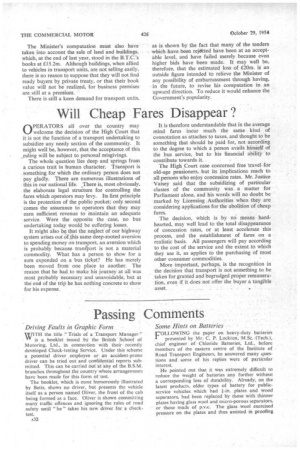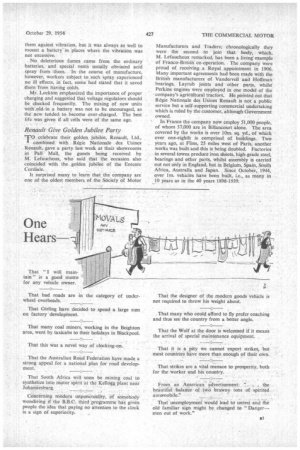Passing Comments
Page 34

Page 35

If you've noticed an error in this article please click here to report it so we can fix it.
Driving Faults in Graphic-Form wini the title." Trials of a Transport Manager" " is a booklet issued by the British* School of Motoring, Ltd., in connection • with their recently developed Check-testing Service. Under this scheme a potential driver employee or an accident-prone driver can be tried out and confidential reports submitted. This can be carried Out at any of the B.S.M. branches throughout the country where arrangements have been made for this form of test.
The booklet, which is most humorously illustrated by Betts, shows no driver, but presents the vehicle itself as a person named Oliver, the front of the cab being formed as a face. Oliver is shown committing many traffic, offences and ignoring the rules of road safety until " he " takes his new driver for a checktest.
A32
SomeHints on Batteries
rOLLOWING the paper on heavy-duty batteries
I presented by Mr: C. P. Lockton,.M.Sc. (Tech.), chief engineer of Chloride Batteries, Ltd., before members of the eastern centre of the Institute of Road Transport Engineers, he answered many questions and some of his replies were of particular interest.
He pointed out that it was extremely difficult to reduce the weight of batteries any further without a corresponding loss of durability. Already, on the latest products, older types of battery for publicservice vehicles which had i-in. plates and wood separators, had been replaced by those with thinner plates having glass wool and micro-porous separators, or those made of p.v.c. The glass wool exercised pressure on the plates and thus assisted in proofing
them against vibration, but it was always as well to mount a battery-in places where the vibration was not excessive.
No deleterious fumes came from the ordinary batteries, and special vents usually obviated acid spray from them. In the course of manufacture, however, workers subject to such spray experienced no ill effects, in fact, some had stated that it saved them from having Colds.
Mr. Lockton emphasized the importance of proper charging and suggested that voltage regulators should be checked frequently. The mixing of new units with old. in a battery was not to be encouraged, as the new tended to become over-charged. The best life :was given if all cells were of the same age.
RenaultGive Golden Jubilee Party
Tc". celebrate their golden jubilee, Renault, Ltd., . combined with Regie Nationale des Usines Renault, gave a party last week at their showrooms in " Pall Mall, the guests being received by M. Lefaucheux, who said that the occasion also coincided with the golden jubilee of the Entente Cordiale.
It surprised many to learn that the company are one of the oldest members of the Society of Motor Manufacturers and Traders; chronologically they were the second to join that body, which, M. Lefaucheux remarked, has been a living' example of Franco-British co-operation. The company were proud of receiving a Royal appointment in 1906. Many important agreements had been made with the British manufacturers of Vandervell mad Hoffman bearings, Layrub joints and other parts, whilst Perkins engines were employed in one model of the company's agricultural tractors. He pointed out that R6gie Nationale des Usines Renault is not a public service but a self-supporting commercial undertaking which is ruled by the customer, although Government owned.
In France the company now employ 51,000 people, of whom 37,000 are in Billancourt alone. The area covered by the works is over 10m. sq. yd., of which over one-eighth is comprised of buildings. Two years ago, at Flins, 25 miles west of Paris, another works was built and this is being doubled. Factories in several towns produce iron sheets, high-grade steel, bearings and other parts, whilst assembly is carried out not only in England, but in Belgium, Spain, South Africa, Australia and Japan. Since October, 1944, over 1m. vehicles have been built, i.e., as many in 10 years as in the 40 years 1898-1939.




























































































